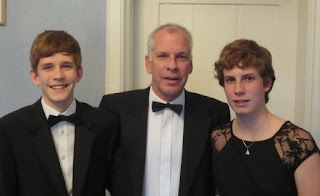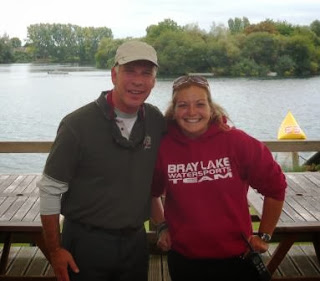Day 17
Distance run in the last 24 hours: 203 nautical miles
Distance to destination: 115 nautical miles
Saving the best till last.
Shortly after sending yesterday's blog, I was off watch
in my cabin when there was a loud bang from the cockpit. This sounded like serious gear failure, but
fortunately only a sail tie retaining a block had parted, and no significant
damage was done. David the skipper
effected quick running repairs, and within 15 minutes we were on our way again.
The Atlantic has relented, and has rewarded us with an exceptional final day at
sea. The huge waves have abated to a
moderate and helpful swell while the trade winds have remained strong and quite
consistent, and we have enjoyed an almost perfect finale. Through the night and all this morning Alcedo
has flown, touching speeds not achieved earlier in the crossing. This morning she has relished the following
seas, surfing down azure waves. The boat
is so perfectly balanced in this twin headsail configuration that helming has
been a matter of fingertip control. At
noon the crew were elated to learn that since noon on Tuesday we had covered
210 miles - a 24 hour record for this passage.
The end is now almost in sight but the anticipated
sightings of other yachts have simply not materialised. We have seen two cargo ships and a tanker
this morning, and we are currently overhauling a (non ARC) yacht in the
distance, but we seem to be arriving in splendid isolation. We have made excellent time over the past few
days and now anticipate crossing the finish line off St Lucia around breakfast
time on Thursday. It is not easy to
estimate how well or how badly we have fared in competitive terms. We have made a safe and seamanlike passage,
which is the most important thing. Our
start number for the cruising division - determined by size of yacht - is
63. This means that Alcedo is the 63rd
biggest yacht in the cruising fleet of approximately 200, and as boat speed is
determined by waterline length, then all other things being equal we ought to
finish in around 63rd place - so this can serve as a very rough and ready
measure of how well (or how badly) we have performed as a crew.

This Atlantic Challenge blog now draws to a close. I will send a final finish time and a few
last details tomorrow. Later, when I am
back in the UK, I will try to add a few photos to illustrate moments I have
written about over the past few weeks - unfortunately it is prohibitively
expensive to send photos across the web on a daily basis. These illustrations
will probably have to wait until after Christmas. My family deserve some time first!
It would be invidious to wrap up the blog without
recording my heartfelt thanks to several people, without whom this 'adventure
of a lifetime' could not have happened.
I am grateful to the many people who encouraged and
supported me (even those who told me that I was mad), and especially to all
those who sponsored me to make the crossing.
There have been some incredibly generous sponsors, but I have equally
been moved by boys from school who individually donated £5 here or £10 there to
the cause. Thank you so much! I am indebted to Tony Little, my Head Master,
who granted me leave from work to make this trip. He must have realised that a few weeks at sea
would 'blow away the proverbial cobwebs' of 13 years living under the same roof
as 50 adolescent schoolboys - which was always 'entertaining'.
The opportunity to cross the Atlantic owes most to David
and Sally Batten. They welcomed an
interloper onto their lovely yacht, and into a close family crew (Jane is
Sally's sister, and Venetia is David's second cousin). They are all hugely experienced, and have
been remarkably unperturbed by my naïveté.
They have been tolerant of my steering, my cooking and my catastrophic failure
to produce the promised fishing tackle. Jane's lunches have become legendary,
and Venetia (who has previously crossed the Atlantic and sailed to Antarctica)
must be the most over-qualified 'ship's boy' in history. For David and Sally, this crossing is part of
a longer journey, as they are staying with Alcedo to sail in the Caribbean for
the present, and beyond - who knows?
They have all been the most congenial of shipmates, and have made my
time on board instructive and above all fun.
It has been hilarious at times. I
now recognise diverse tropical sea birds at a glance, and I shall never forget
the 'alcoholic oranges'.
I want to pay tribute to David and Olivia Chapple - two
of the bravest people I know. The way
they have created something positive and invaluable to others from the tragedy
they have experienced has been inspirational.
They have given me wonderful encouragement, and they know that without
Horatio, and without their example, I would never have attempted this voyage -
a trip which acknowledges something of their son's spirit of adventure. Those who are not familiar with this story
can discover the details at
www.horatiosgarden.org.uk
Finally, my family.
Their messages have been my daily treat.
Understandably Véronique was pretty sceptical about the whole project,
knowing better than anyone my unique capacity for disaster. She has tolerated my eccentric desire to roam
the ocean and given me a fool's pardon, but I know it has not been easy having
a partner loose on the wide and lonely sea.
Without Jonathan the blog would have faltered - he has reliably
transmitted my messages on a daily basis.
My absence at sea meant that I failed to see him play in a rugby final
at school, which would have delighted me, and embarrassed him. Most shameful of all, the dates of the ARC
meant that I missed my daughter's 18th birthday. Fortunately Melanie is the true sailor in the
family, and understands something of what this trip has meant to me. I hope that she can forgive me.























